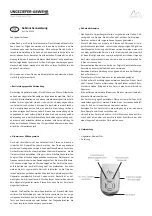
MIA-M10Q - Integration manual
The RAM available in the chip limits the size of the buffer. To make the best use of the available
space, users can select what data they want to batch. When batching is enabled, a basic set of
data is stored and the configuration flags EXTRAPVT and EXTRAODO can be used to store more
detailed information about the position fixes. However, enabling the EXTRAPVT and EXTRAODO
flags reduces the number of fixes that can be batched.
The receiver will reject the configuration if it cannot allocate the required buffer memory. To ensure
robust operation of the receiver the limits in
EXTRAPVT
EXTRAODO
Maximum number of epochs
0
0
600
0
1
443
1
0
309
1
1
261
Table 28: Maximum number of batched epochs
It is recommended to disable all periodic output messages when using data batching. This
improves system robustness and also helps ensure that the output of batched data is not
delayed by other messages.
The buffer size is set up in terms of navigation epochs. This means that the time that can
be covered with a certain buffer depends on the navigation rate. This rate can be set via the
"CFG-RATE-" configuration group.
2.14.3 Retrieval
UBX-LOG-RETRIEVEBATCH message starts the process which allows the receiver to output batch
entries. Batching must not be stopped for readout because all batched data is lost when the feature
is disabled.
Batched fixes are always retrieved starting with the oldest fix in the buffer and progressing towards
newer ones. There is no way to skip certain fixes during retrieval.
When a UBX-LOG-RETRIEVEBATCH message is sent the receiver transmits all batched fixes. It is
recommended to send a retrieval request with
sendMonFirst
set. This way the receiver will send
a UBX-MON-BATCH message first that contains the number of fixes in the batching buffer. This
information can be used to detect when the u-blox receiver finishes sending data.
Once retrieval has started, the receiver will first send UBX-MON-BATCH message if
sendMonFirst
option was selected in the UBX-LOG-RETRIEVEBATCH message. After that, it will send UBX-LOG-
BATCH messages with the batched fixes.
To maximize the speed of transfer, it is recommended that a high communication data rate is used.
The receiver will discard retrieval request while processing a previous UBX-LOG-
RETRIEVEBATCH message.
The receiver does
not
acknowledge the reception of UBX-LOG-RETRIEVEBATCH message.
The receiver responds with UBX-MON-BATCH (optional) and UBX-LOG-BATCH messages.
2.15 CloudLocate
In CloudLocate setup, the host processor of the customer application fetches a set of satellite signal
measurements from the receiver and sends those to the u-blox CloudLocate service for position
calculation. The CloudLocate service uses these measurements and current assistance data to
UBX-21028173 - R01
2 Receiver functionality
Page 61 of 89
C1-Public
















































